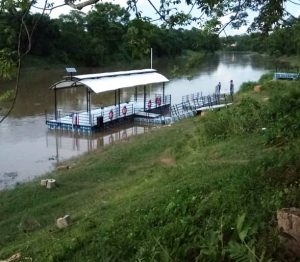By Rajeev Bhattacharyya
 India’s Northeast has secured an outlet through the rivers of Bangladesh in a development that will have far-reaching implications for the economy of the landlocked region.
India’s Northeast has secured an outlet through the rivers of Bangladesh in a development that will have far-reaching implications for the economy of the landlocked region.
Last month, the chief minister of Tripura, Biplab Kumar Deb, received the first trial cargo container ship sailing from Kolkata and through the neighboring country to the state. Tripura, in India’s Northeast, shares an 856 kilometer-long border with Bangladesh.
A temporary jetty was constructed at Sonamura for the new waterway through the Gomati River flowing between Tripura and Bangladesh.
Speaking to reporters, Deb explained that the new arrangement reduced the distance between Kolkata and Tripura’s capital, Agartala, from 1600 to 600 kilometers. Its use would therefore help decrease prices of essential commodities, he noted.
Tripura was linked with the rivers of Bangladesh following five new protocol routes that were finalized between the two neighbors. The Sonamura-Daudkandi route on Tripura’s Gomti River and Rajshahi-Dhulian-Rajshahi route were added to the list of Indo-Bangladesh Protocol (IBP) routes.
The Protocol on Transit and Trade through inland waterways, first signed by Bangladesh and India in 1972, has a total of 10 routes.
India’s northeastern frontier has long suffered from insufficient connectivity with the mainland. Surrounded by China, Bhutan, Myanmar, and Bangladesh, its only land-based connection with the rest of the country is a narrow corridor of 22 kilometers at Siliguri colloquially called the “Chicken’s Neck.”
The strategic importance of the Chicken’s Neck for India became glaringly clear during the 2017 Doklam standoff with China. At that time, India claimed that China’s road construction in the disputed Doklam region in Bhutan amounted to shifting the trijunction between the three countries. Effectively, China’s construction activity in Doklam would have brought its military closer to the Chicken’s Neck.
Serious efforts have been on for alternate routes to the country’s Northeast over the past several decades. The Kaladan Multi Modal Transport Transit Project envisaged linking the eastern ports of India with the northeastern state of Mizoram and the rest of the northeast through Myanmar.
However, progress on the Kaladan project has been extremely sluggish and its completion remains uncertain. Last year, some Indian employees engaged with the firm executing the scheme were abducted and later released by the Arakan Army in Myanmar. Conflict between the rebels and government troops has since escalated in Myanmar’s Chin and Rakhine states, where the project is being executed.
The uncertainty over the Kaladan project has enhanced the significance of the routes through Bangladesh for a passage to and from India’s Northeast. However, there are various low-depth stretches along the rivers in Bangladesh that need dredging. Work is on to facilitate seamless navigation between Sirajgang and Daikhowa on the Jamuna River (Brahmaputra) and between Ashuganj and Zakiganj on the Kushiyara River. These projects are expected to be completed next year.
One plan is to connect the jetties along the border with the East-West Corridor (highway) of 3,300 kilometers that begins at Porbandar in Gujarat and terminates at Assam’s Silchar in the Northeast. But like the fate of several highway projects in the region, many deadlines for the completion of East-West Corridor have already been missed. Likewise, the highway between Tripura and Silchar would also have to be upgraded and broadened for handling a larger volume of traffic.
The Indian government’s focus on utilizing the waterways of Bangladesh as means of transit between the Northeast and the rest of the country is in sync with other ambitious plans that have been firmed up for the landlocked region. In the twin projects Bharatmala and Sagarmala, the Northeast is envisaged to develop as a commercial hub.
It is imagined that Assam, the most populous state in the region, will be the intersecting point in a network of arteries through air, rail, and water linking the region to distant capitals in Asia. The historic National Highway-39, which connects Assam with the border states of Nagaland and Manipur, will become part of Asian Highway-1 originating in Tokyo and extending all the way to the border of Bulgaria, according to some plans.
Rajeev Bhattacharyya is a senior journalist in Assam, India.
No comments:
Post a Comment